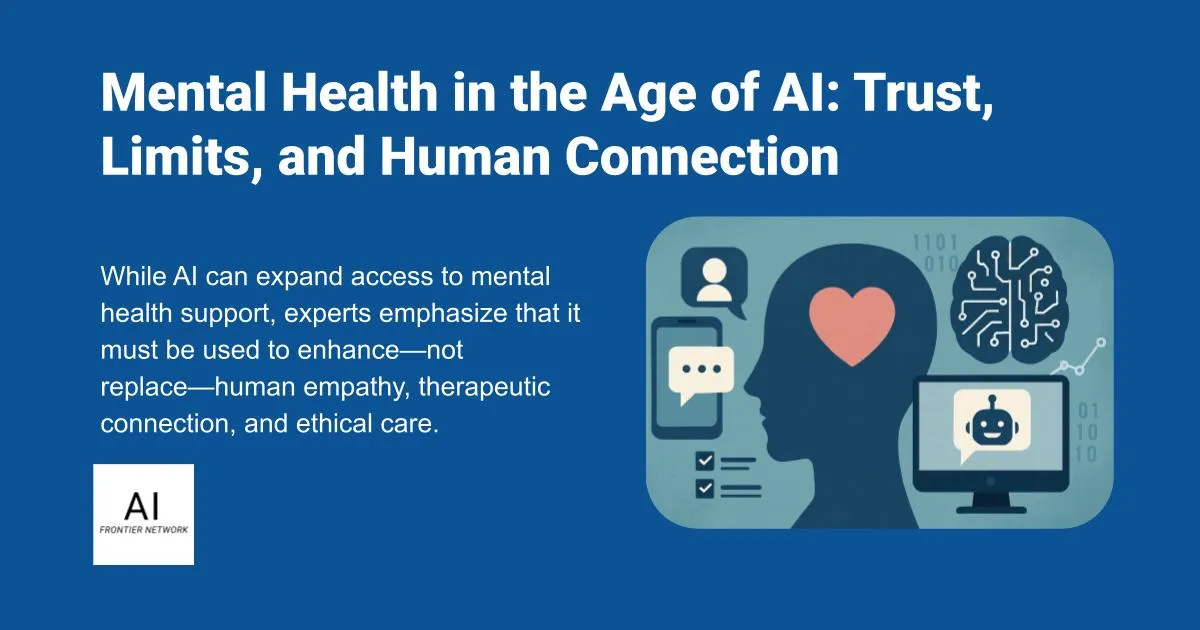As artificial intelligence weaves itself into every corner of modern life, mental health stands as one of its most promising, and precarious frontiers. From 24/7 chatbots to diagnostic assistants, AI offers unprecedented opportunities to expand access, support early detection, and reduce stigma. Yet across expert voices in technology, psychology, and ethics, one principle echoes loudly: AI must extend human care, not attempt to replace it.
The Promise: Greater Reach, Lower Barriers
Mental-health support remains out of reach for many because of high costs, clinician shortages, and lingering stigma. Here, AI has already shown genuine potential.
“AI can certainly expand access to mental-health support”
Chatbots can check in with users, flag risks, or provide coping strategies. Apps integrating expert-backed workflows like Wysa or Woebot became lifelines during the pandemic—meeting people where they are, on their phones, at any hour.
“AI holds significant promise in augmenting mental-health support, particularly in increasing access to care and reducing stigma”
“AI-powered diagnostics can help screen symptoms, provide supportive interactions, and offer constant engagement.”
“AI-driven apps that blend mindfulness and guided workflows are already helping people manage anxiety and build healthier habits”
The Risk: Simulated Support, Real Consequences
Despite these benefits, experts are aligned on a hard boundary: AI must never be mistaken for a full therapeutic replacement.
“Real therapy needs empathy, intuition, and trust, qualities technology can’t replicate”
Pankaj Pant
Mental health care is deeply relational. It’s about being witnessed, not just responded to. It requires co-created meaning, cultural nuance, and human presence.
“Therapy is about co-creating meaning in the presence of someone who can hold your story, and sometimes, your silence”
Dr. Anuradha Rao
Even well-meaning tools can do harm if we underestimate their limits—through misdiagnosis, toxic recommendation loops, or addictive engagement patterns.
“Heavy use of tools like ChatGPT can reduce memory recall, creative thinking, and critical engagement. AI could do more harm than good, even while feeling helpful”
“Most large language models are trained on open-internet data riddled with bias and misinformation, serious risks in mental-health contexts where users are vulnerable”
The Safeguards: Trust by Design
When it comes to AI in mental health, the technology itself isn’t the greatest challenge; trust is.
“In my work across AI and cloud transformation, especially in regulated sectors, I’ve learned that the tech is often the easy part. The more complicated, and more important, part is designing for trust, safety, and real human outcomes”
Pankaj Pant
Designing for trust means building guardrails into every layer:
- Transparent, explainable models
- Human-in-the-loop oversight for any diagnostics
- Regular ethics reviews and bias audits
- Consent-based, dynamic data sharing
- Limits on addictive features and engagement-optimization loops
“We need guardrails: human oversight, explainability, and ethical reviews. And above all, we need to build with people, not just for them”
Pankaj Pant
“Responsible innovation means embedding ethics, empathy, and safeguards into every layer, from training data to user interface”
Purusoth Mahendran
“Innovation matters most when it helps people feel seen, heard, and supported… Without safeguards, AI can worsen mental health, think toxic recommendation loops or deepfake bullying”
The Guiding Principle: Augmentation, Not Automation
From engineers to clinicians, voices across the ecosystem converge on one principle: augment—don’t automate.
“AI must prioritize augmentation, not replacement. Human connection and contextual understanding can’t, and shouldn’t be automated”
Even in structured modalities like CBT, experts urge caution, especially for vulnerable groups such as veterans with PTSD or individuals with multiple psychiatric diagnoses.
“Until large-scale trials validate AI-CBT tools, they must serve only as adjuncts, not replacements for neuropsychiatric evaluation”
Abhishek Biswas
The Future: Human + Machine, Together
If we center empathy, embed ethics, and collaborate across disciplines, AI can become a powerful partner in care.
“The future isn’t human versus machine. It’s human plus machine, together, better”
To reach that future we must:
- Involve clinicians and patients in co-design
- Train AI on context-aware, ethically curated data
- Incentivize well-being, not screen time
- Govern innovation with humility, not hype
“Use AI to extend care, not replace it”
Pankaj Pant
Closing Thought: Code With Care
Mental health is not a product; it’s a human right. And technology, if built with compassion and rigor, can be a powerful ally.
“Let’s code care, design for dignity, and innovate with intentional empathy”
Nikhil Kassetty
“Build as if the user is your sibling, would you trust a chatbot to diagnose your sister’s depression?”
Ultimately, the goal is not just functional AI. It’s psychologically safe, culturally competent, ethically aligned AI, built with people, for people, and always in service of the human spirit.












